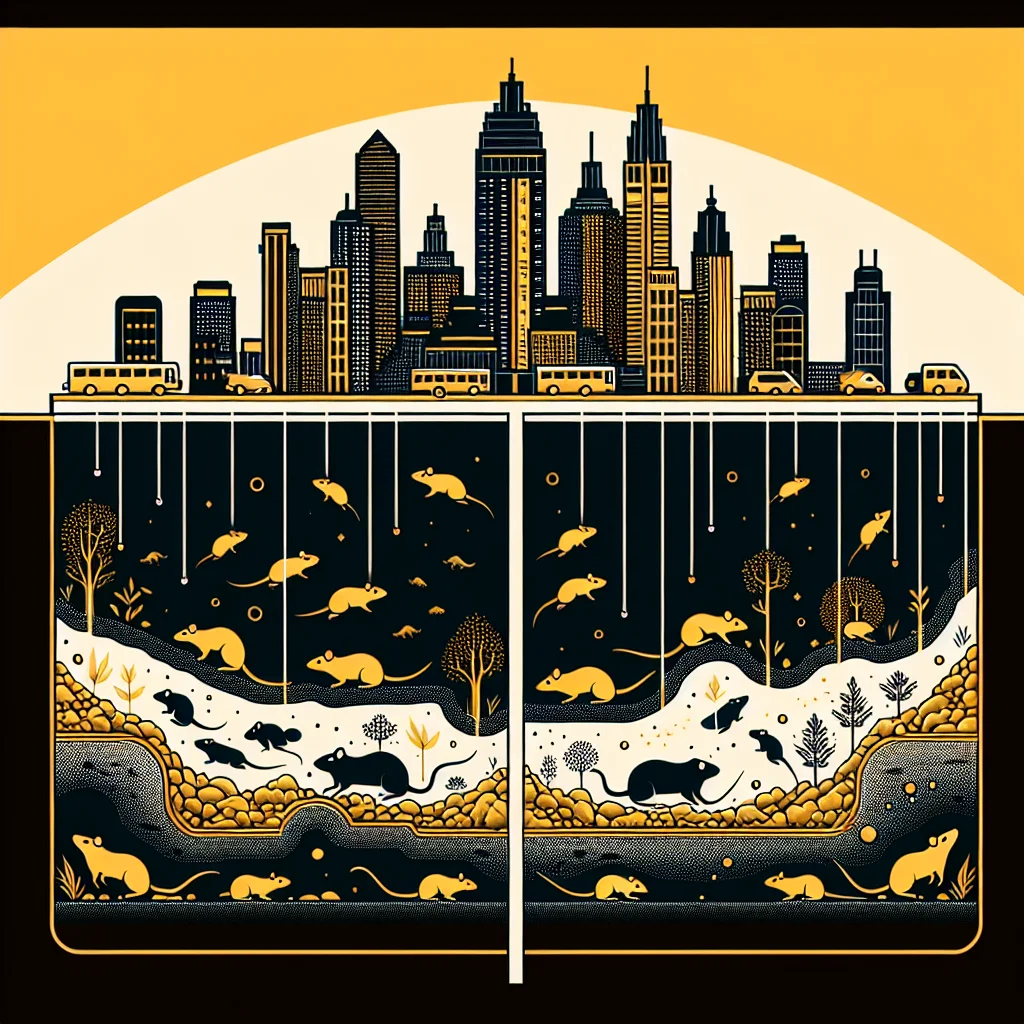3 minute read •
Comments
Subterranean Sanctuaries: The Battle to Save Ratopolis's Underground Biomes
March 21, 2025

Burrowed beneath the vibrant cityscape of Ratopolis lies an intricate web of underground ecosystems, crucial to our city's health, yet perilously endangered by the torrent of urban sprawl. The urgent need for a harmonious balance between development and ecological preservation has never been clearer.
Ratopolis’s subterranean biomes teem with an array of unique life forms that are vital in sustaining the city’s biodiversity and ecological equilibrium. These underground sanctuaries are not only home to rare fungi and insects but also serve as critical water filtration systems and carbon sinks.
Yet, the relentless pace of urban development poses a significant threat. Recent construction projects have encroached upon these delicate habitats, with statistics indicating a 15% reduction in underground biomes in just the past five years. This habitat loss imperils local species and undermines ecosystem services they provide.
Dr. Whiskers, a preeminent biologist, warns, "The ecological ramifications of losing these biomes could be catastrophic. They are vital to our city's health and resilience." His call to protect these habitats is echoed by Mr. Squeakwell, an esteemed urban planner, who asserts, "Integrating green space into city projects is not just possible but essential. We need innovative solutions that allow development and nature to thrive alongside each other."
Community members are also voicing their concerns. Ratilda, a local resident, stresses, "We can't just burrow our heads in the sand. Our future depends on these biomes!" Cheddar McNibble, an outspoken activist, adds, "It's a rat race against time to save our underground sanctuaries." Their sentiments reflect a growing grassroots movement demanding action.
Successful case studies from cities like Whiskertown offer hope. There, policymakers have implemented sustainable practices, preserving over 90% of their natural habitats amidst urban growth. Ratopolis could adopt similar strategies, fostering eco-friendly developments that prioritize ecological preservation.
Nonetheless, some argue that urban expansion is crucial for economic growth and housing. Balancing these interests requires innovative urban planning and policies that prioritize environmental sustainability without stifling Ratopolis's economic potential.
Historically, Ratopolis has navigated urban growth at the expense of natural habitats, but the tide is shifting. Upcoming projects, such as the Green Burrow Initiative, aim to mend past oversights, ensuring future developments mitigate environmental impact.
The onus now rests on policymakers and citizens alike to safeguard Ratopolis's natural heritage. By supporting sustainable development and community initiatives, we can honor the intricate balance our subterranean sanctuaries provide. As urbanization advances, we must remember: preserving these biomes isn't just a choice. It's an obligation for our city's future and well-being.
Let us dig deep and forge a sustainable path forward—together. This is more than conservation; it’s a testament to our commitment to a thriving, balanced Ratopolis.
Looking for more in-depth news and exclusive content? Follow RAT TV for real-time updates, behind-the-scenes insights and the latest breaking news.
Ratopolis’s subterranean biomes teem with an array of unique life forms that are vital in sustaining the city’s biodiversity and ecological equilibrium. These underground sanctuaries are not only home to rare fungi and insects but also serve as critical water filtration systems and carbon sinks.
Yet, the relentless pace of urban development poses a significant threat. Recent construction projects have encroached upon these delicate habitats, with statistics indicating a 15% reduction in underground biomes in just the past five years. This habitat loss imperils local species and undermines ecosystem services they provide.
Dr. Whiskers, a preeminent biologist, warns, "The ecological ramifications of losing these biomes could be catastrophic. They are vital to our city's health and resilience." His call to protect these habitats is echoed by Mr. Squeakwell, an esteemed urban planner, who asserts, "Integrating green space into city projects is not just possible but essential. We need innovative solutions that allow development and nature to thrive alongside each other."
Community members are also voicing their concerns. Ratilda, a local resident, stresses, "We can't just burrow our heads in the sand. Our future depends on these biomes!" Cheddar McNibble, an outspoken activist, adds, "It's a rat race against time to save our underground sanctuaries." Their sentiments reflect a growing grassroots movement demanding action.
Successful case studies from cities like Whiskertown offer hope. There, policymakers have implemented sustainable practices, preserving over 90% of their natural habitats amidst urban growth. Ratopolis could adopt similar strategies, fostering eco-friendly developments that prioritize ecological preservation.
Nonetheless, some argue that urban expansion is crucial for economic growth and housing. Balancing these interests requires innovative urban planning and policies that prioritize environmental sustainability without stifling Ratopolis's economic potential.
Historically, Ratopolis has navigated urban growth at the expense of natural habitats, but the tide is shifting. Upcoming projects, such as the Green Burrow Initiative, aim to mend past oversights, ensuring future developments mitigate environmental impact.
The onus now rests on policymakers and citizens alike to safeguard Ratopolis's natural heritage. By supporting sustainable development and community initiatives, we can honor the intricate balance our subterranean sanctuaries provide. As urbanization advances, we must remember: preserving these biomes isn't just a choice. It's an obligation for our city's future and well-being.
Let us dig deep and forge a sustainable path forward—together. This is more than conservation; it’s a testament to our commitment to a thriving, balanced Ratopolis.
Looking for more in-depth news and exclusive content? Follow RAT TV for real-time updates, behind-the-scenes insights and the latest breaking news.
Comments